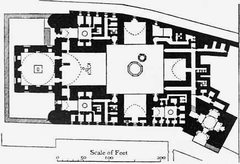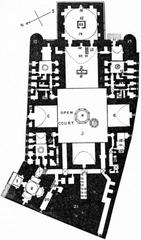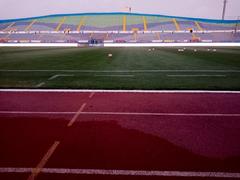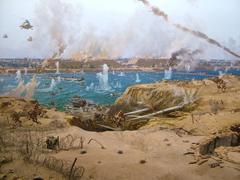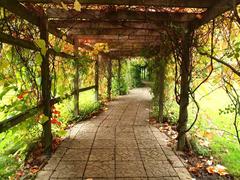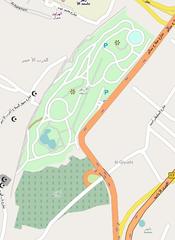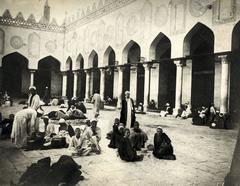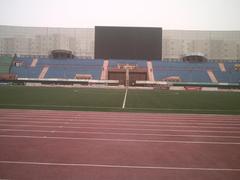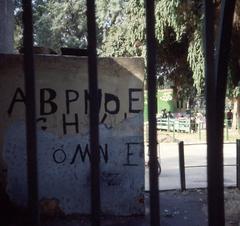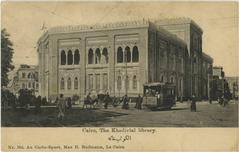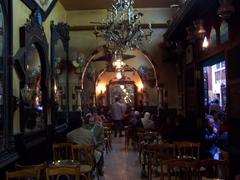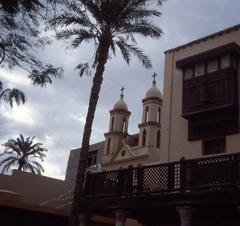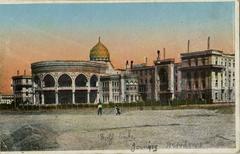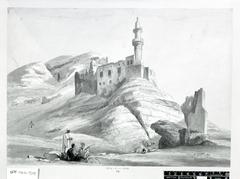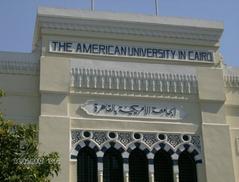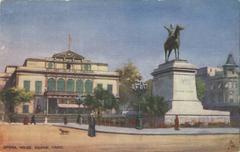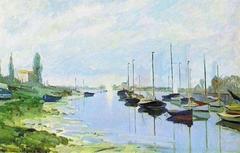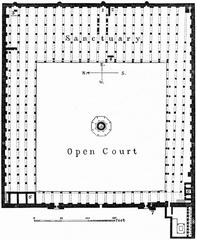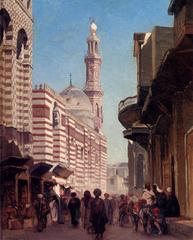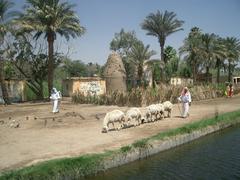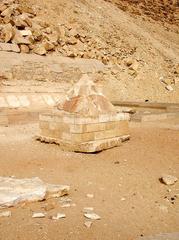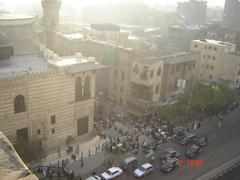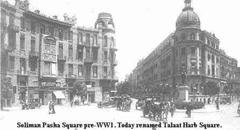
Visiting Hours, Tickets, and Historical Significance of Mosque-Madrassa of Sultan Hassan, Cairo
Published Date: 16/08/2024
Introduction to the Mosque-Madrassa of Sultan Hassan
The Mosque-Madrassa of Sultan Hassan in Cairo Governorate, Egypt, is a monumental testament to Islamic architecture and historical significance. This iconic landmark, constructed under the orders of Sultan Hassan in 1356 CE, embodies the grandeur and innovation of Mamluk architecture. Covering nearly 8,000 square meters, it remains one of the largest mosques in the world, showcasing architectural marvels such as its enormous egg-shaped dome and the unique arrangement of the mausoleum between two minarets (Egipto.com). The mosque’s dual function as both a place of worship and a center for Islamic education highlights its cultural and educational importance. Visitors to this historical site can explore its vast central courtyard, intricate mosaics, and the iwans dedicated to the four Sunni schools of thought, making it a must-visit destination for anyone interested in Cairo’s rich history and architectural heritage.
Contents Overview
- Introduction
- Historical Background
- Construction and Architectural Significance
- Innovations in Design
- Historical Context and Construction Challenges
- Architectural Features and Layout
- Legacy and Influence
- Visiting the Mosque-Madrassa of Sultan Hassan
- Visiting Hours and Tickets
- Travel Tips
- Accessibility
- Special Events and Guided Tours
- Photographic Spots
- Nearby Attractions
- Conclusion
- FAQ
Historical Background
Construction and Architectural Significance
The Mosque-Madrassa of Sultan Hassan, located in Cairo, Egypt, is a monumental example of Mamluk architecture. Its construction began in 1356 CE under the orders of Sultan Hassan, a ruler of the Mamluk Sultanate. The mosque is renowned for its grand scale and architectural innovations, making it one of the most significant Islamic structures of its time. Covering nearly 8,000 square meters, it stands as one of the largest mosques in the world (Egipto.com).
The mosque’s construction was supervised by Amir Mohammed ibn Biylik, as indicated by an inscription on the mosque. The project was incredibly costly, with expenses reaching 30,000 dirhams per day, making it the most expensive mosque in medieval Cairo (Egipto.com). The mosque’s dimensions are monumental: it is 150 meters long, with walls standing 35 meters high and a minaret reaching almost 70 meters in height.
Innovations in Design
The Mosque-Madrassa of Sultan Hassan introduced several architectural innovations that influenced the construction of later mosques in the Arab world. One of the most notable features is its enormous egg-shaped dome, a design element that was unprecedented at the time and had not been seen in other mosques across Egypt, Syria, the Maghreb, or Yemen (Egipto.com).
Another significant innovation was the arrangement of the mausoleum between two minarets, positioned behind the prayer hall. This was a bold move, as it could have been considered a desecration of the sacred scriptures in earlier times. Additionally, the mosque was designed to have four minarets, with twin minarets on each side. However, only three minarets were completed (Egipto.com).
Historical Context and Construction Challenges
The construction of the Mosque-Madrassa of Sultan Hassan was fraught with challenges and controversies. Sultan Hassan did not live to see the completion of his monumental project. According to one version of events, a minaret collapsed during construction, killing over 300 people. This incident was seen as a bad omen, leading to rumors and eventually the assassination of Sultan Hassan 33 days after the collapse (Egipto.com).
Another version suggests that Sultan Hassan’s death was due to the exhausting demands he placed on the workers and the prevailing corruption within his government. He angered many people by placing his associates in positions that had been occupied by others for years. This led to a plot to assassinate him, which was carried out by Jalbugha al-Umari, the commander-in-chief of his army, whom the sultan had believed to be loyal (Egipto.com).
Architectural Features and Layout
Upon entering the mosque, visitors are greeted by a vast central courtyard adorned with a fine mosaic design and an ablution pool in the middle. This pool is used for the ritual purification of certain body parts before prayer, known as Salat. The courtyard provides access to the central prayer hall and four secondary rooms, or iwans, each dedicated to one of the four Sunni schools of thought (Egipto.com).
The iwans are notable for their chandeliers hanging from chains and their red and black borders. Each iwan contains a madrasa with its own courtyard and four floors of cells for students and teachers. At the back of the mosque, there is a mausoleum dedicated to Sultan Hassan, further emphasizing the mosque’s dual function as both a place of worship and a center for Islamic education (Egipto.com).
Legacy and Influence
The Mosque-Madrassa of Sultan Hassan has left a lasting legacy on Islamic architecture. Its innovative design elements, such as the egg-shaped dome and the arrangement of the mausoleum, set new standards for mosque construction in the Arab world. The mosque’s grand scale and architectural beauty continue to attract visitors and scholars alike, making it a significant cultural and historical landmark in Cairo (Egipto.com).
Visiting the Mosque-Madrassa of Sultan Hassan
Visiting Hours and Tickets
The Mosque-Madrassa of Sultan Hassan is open daily from 8 am to 5 pm. Visitors can purchase a combined ticket with the nearby Al Rifa’i Mosque, with prices set at 60 EGP for regular adult admission and 30 EGP for accredited students (Egipto.com).
Travel Tips
The mosque is located next to Al Rifa’i Mosque, and the two are often visited together as part of a tour that includes other points of interest in the Saladin Citadel, such as the Ibn Tulun Mosque and the Alabaster Mosque. The most convenient way to visit is by cab or private car from your hotel, with the price agreed upon in advance. Many excursions to the Saladin Citadel include transfers to and from the site. It is advisable to wear comfortable shoes and modest clothing, as the mosque is an active place of worship.
Accessibility
The mosque is relatively accessible for visitors with mobility issues, although some areas might be challenging due to the historical nature of the building. It’s recommended to check in advance and plan accordingly.
Special Events and Guided Tours
The mosque occasionally hosts special events and religious ceremonies. Guided tours are available and highly recommended for those interested in a deeper understanding of the site’s historical and architectural significance. These tours often provide unique insights and stories not covered in general information.
Photographic Spots
Photography enthusiasts will find numerous spots within the mosque that offer stunning views and angles. The central courtyard and the iwans are particularly photogenic, as are the minarets and the intricate designs within the prayer hall.
Nearby Attractions
In addition to the Mosque-Madrassa of Sultan Hassan, visitors can explore nearby attractions such as the Al Rifa’i Mosque, the Ibn Tulun Mosque, and the Alabaster Mosque. These sites offer a rich tapestry of Cairo’s historical and cultural heritage.
Conclusion
The Mosque-Madrassa of Sultan Hassan stands as a monumental testament to the architectural and cultural achievements of the Mamluk era. Its historical significance, innovative design, and grand scale make it a must-visit destination for anyone traveling to Cairo. For more information, consider checking out related articles, downloading our mobile app Audiala, or following us on social media for the latest updates.
FAQ
Q: What are the visiting hours for the Mosque-Madrassa of Sultan Hassan?
A: The mosque is open daily from 8 am to 5 pm.
Q: How much are the tickets?
A: The combined ticket with Al Rifa’i Mosque costs 60 EGP for adults and 30 EGP for students.
Q: Are guided tours available?
A: Yes, guided tours are available and recommended for a deeper understanding of the site.
Q: What should I wear when visiting the mosque?
A: Visitors should wear modest clothing as the mosque is an active place of worship.
Summary and Key Takeaways
In summary, the Mosque-Madrassa of Sultan Hassan stands as a beacon of Mamluk architectural brilliance and Islamic cultural heritage. Its historical significance, coupled with its innovative design and grand scale, continues to fascinate visitors and scholars alike. By exploring its architectural features, understanding its historical context, and experiencing its cultural significance, visitors can gain a deeper appreciation of this monumental structure. Whether visiting during the tranquil hours of the morning or joining a guided tour for in-depth insights, the Mosque-Madrassa of Sultan Hassan offers a unique and enriching experience. For those planning a trip to Cairo, this landmark is an essential stop, providing a glimpse into the grandeur of Islamic history and architecture (Egipto.com, Egypt Uncovered).
Sources and Further Reading
- Egipto.com. (n.d.). Sultan Hassan Mosque. Retrieved from Egipto.com
- Egypt Uncovered. (n.d.). The Mosque and Madrasa of Sultan Hassan. Retrieved from Egypt Uncovered
- Khan Academy. (n.d.). Madrasa and Friday Mosque of Sultan Hasan, Cairo. Retrieved from Khan Academy
- Travel2Egypt. (n.d.). Mosque-Madrassa of Sultan Hassan. Retrieved from Travel2Egypt
- Lonely Planet. (n.d.). Mosque-Madrassa of Sultan Hassan. Retrieved from Lonely Planet
- Audiala. (n.d.). Sultan Hassan Mosque. Retrieved from Audiala
